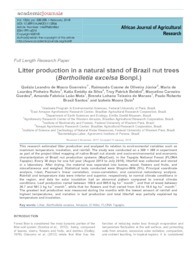Litter production in a natural stand of Brazil nut trees (Bertholletia excelsa Bonpl.).
Litter production in a natural stand of Brazil nut trees (Bertholletia excelsa Bonpl.).
Autoria: GUERREIRO, Q. L. de M.; OLIVEIRA JUNIOR, R. C. de; RUIVO, M. de L. P.; SILVA, K. E. da; BELDINI, T. P.; GUEDES, M. C.; MOTA, A. F. L.; MORAES, B. L. T. de; SANTOS, P. R. B.; DUIN, I. M.
Resumo: This research estimated litter production and analyzed its relation to environmental variables such as maximum temperature, insolation, and rainfall. The study was conducted on a 300 × 300 m experiment as part of the project titled mapping of native Brazil nut stands and socio-environmental and economic characterization of Brazil nut production systems (MapCast), in the Tapajós National Forest (FLONA Tapajós). Every 30 days for one full year (August 2015 to July 2016), litterfall was collected and stored in a laboratory. After drying, the material was separated into leaves, wood, flowers and fruits, and miscellaneous and weighed. Statistical tests conducted were Shapiro-Wilk (5%), Principal coordinate analysis, t-test, Pearson?s linear correlation, cross-correlation, and canonical redundancy analysis. Rainfall and temperature data were inferior and superior, respectively, to normal climate conditions in the region, and data for solar insolation had an abnormal pattern compared to normal climate conditions. Leaf production varied between 169.9 and 965.6 kg ha-1 month-1, and that of wood between 26.7 and 501.3 kg ha-1 month-1, while that for flowers and fruit varied from 0.6 to 19.6 kg ha-1 month-1. The greatest leaf production was measured during the months with the lowest amount of rainfall and highest temperatures, and variation in leaf production and total litterfall was partially explained by temperature and insolation.
Ano de publicação: 2018
Tipo de publicação: Artigo de periódico
Unidade: Embrapa Amazônia Oriental
Palavras-chave: Castanha-do-brasil, Lixo, Meio Ambiente, Produção
Observações
1 - Por padrão são exibidas publicações dos últimos 20 anos. Para encontrar publicações mais antigas, configure o filtro ano de publicação, colocando o ano a partir do qual você deseja encontrar publicações. O filtro está na coluna da esquerda na busca acima.
2 - Para ler algumas publicações da Embrapa (apenas as que estão em formato ePub), é necessário ter, no celular ou computador, um desses softwares gratuitos. Sistemas Android: Google Play Livros; IOS: iBooks; Windows e Linux: software Calibre.
Acesse outras publicações
Acesse a Base de Dados da Pesquisa Agropecuária (BDPA) para consultar o acervo completo das bibliotecas da Embrapa.

